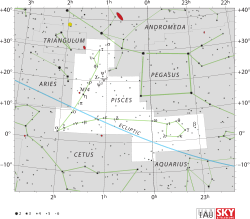Tau Piscium
Tau Piscium (τ Piscium) is an orange-hued star in the zodiac constellation of Pisces. With an apparent visual magnitude of +4.52,[2] it is a dim star but visible to the naked eye. Based upon an annual parallax shift of 19.32 mas as seen from Earth,[1] it is located around 169 light years from the Sun. It is most likely (96% chance) a member of the thin disk population.[5]
 | |
| Observation data Epoch J2000.0 Equinox J2000.0 (ICRS) | |
|---|---|
| Constellation | Pisces |
| Right ascension | 01h 11m 39.63647s[1] |
| Declination | +30° 05′ 22.6909″[1] |
| Apparent magnitude (V) | +4.518[2] |
| Characteristics | |
| Spectral type | K0.5 IIIb[3] |
| U−B color index | +1.016[2] |
| B−V color index | +1.094[2] |
| Astrometry | |
| Radial velocity (Rv) | 36.36±0.34[4] km/s |
| Proper motion (μ) | RA: +73.88[1] mas/yr Dec.: −38.30[1] mas/yr |
| Parallax (π) | 19.32 ± 0.24[1] mas |
| Distance | 169 ± 2 ly (51.8 ± 0.6 pc) |
| Absolute magnitude (MV) | +1.033[5] |
| Details[4] | |
| Mass | 1.69[6] M☉ |
| Radius | 10 R☉ |
| Luminosity | 44.7 L☉ |
| Surface gravity (log g) | 2.6 cgs |
| Temperature | 4,624±5 K |
| Metallicity [Fe/H] | −0.04 dex |
| Rotational velocity (v sin i) | 2.2 km/s |
| Age | 2.27[4] Gyr |
| Other designations | |
| Database references | |
| SIMBAD | data |
This is an evolved K-type giant star with a stellar classification of K0.5 IIIb.[3] It is about 2.27[4] billion years and is a red clump star on the horizontal branch, which indicates it is generating energy through helium fusion at its core.[8] The star has 1.7[6] times the mass of the Sun and has expanded to about 10 times the Sun's radius.[4] It is radiating 45 times the Sun's luminosity from its photosphere at an effective temperature of 4,624 K.[4]
Naming
In Chinese, 奎宿 (Kuí Sù), meaning Legs (asterism), refers to an asterism consisting of refers to an asterism consisting of τ Piscium, η Andromedae, 65 Piscium, ζ Andromedae, ε Andromedae, δ Andromedae, π Andromedae, ν Andromedae, μ Andromedae, β Andromedae, σ Piscium, 91 Piscium, υ Piscium, φ Piscium, χ Piscium and ψ¹ Piscium. Consequently, the Chinese name for τ Piscium itself is 奎宿十一 (Kuí Sù shíyī, English: the Eleventh Star of Legs.)[9]
References
- van Leeuwen, F. (2007), "Validation of the new Hipparcos reduction", Astronomy and Astrophysics, 474 (2): 653–664, arXiv:0708.1752, Bibcode:2007A&A...474..653V, doi:10.1051/0004-6361:20078357.
- Jennens, P. A.; Helfer, H. L. (September 1975), "A new photometric metal abundance and luminosity calibration for field G and K giants", Monthly Notices of the Royal Astronomical Society, 172: 667–679, Bibcode:1975MNRAS.172..667J, doi:10.1093/mnras/172.3.667.
- Keenan, Philip C.; McNeil, Raymond C. (1989), "The Perkins catalog of revised MK types for the cooler stars", Astrophysical Journal Supplement Series, 71: 245, Bibcode:1989ApJS...71..245K, doi:10.1086/191373.
- Massarotti, Alessandro; et al. (January 2008), "Rotational and Radial Velocities for a Sample of 761 HIPPARCOS Giants and the Role of Binarity", The Astronomical Journal, 135 (1): 209–231, Bibcode:2008AJ....135..209M, doi:10.1088/0004-6256/135/1/209.
- Soubiran, C.; et al. (2008), "Vertical distribution of Galactic disk stars. IV. AMR and AVR from clump giants", Astronomy and Astrophysics, 480 (1): 91–101, arXiv:0712.1370, Bibcode:2008A&A...480...91S, doi:10.1051/0004-6361:20078788.
- Luck, R. Earle (September 2015), "Abundances in the Local Region. I. G and K Giants", The Astronomical Journal, 150 (3): 23, arXiv:1507.01466, Bibcode:2015AJ....150...88L, doi:10.1088/0004-6256/150/3/88, 88.
- "tau Psc". SIMBAD. Centre de données astronomiques de Strasbourg. Retrieved 2017-07-24.
- Mishenina, T. V.; et al. (September 2006), "Elemental abundances in the atmosphere of clump giants", Astronomy and Astrophysics, 456 (3): 1109–1120, arXiv:astro-ph/0605615, Bibcode:2006A&A...456.1109M, doi:10.1051/0004-6361:20065141.
- (in Chinese) AEEA (Activities of Exhibition and Education in Astronomy) 天文教育資訊網 2006 年 5 月 19 日